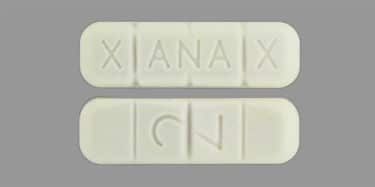Xanax (alprazolam) is a psychiatric medicine used as a sedative. It quickly affects chemicals in the brain and relieves severe fear and anxiety attacks. It is taken for a short period as it has risk of dependence. If suddenly discontinued without informing your doctor, it can cause withdrawal symptoms such as severe anxiety, wooziness, or insomnia. Thus, when the treatment is over, the intake of medicine should be stopped incrementally and under control of the doctor. Never take this medicine with alcohol. Besides, taking it with other narcotic drugs at the same time may be fatal. The common side effects of Xanax are depression, drowsiness, forgetfulness, balance, and speech disorders. The medication should exactly be taken in line with the instructions of the doctor and should not be abused.
Table of Contents
What is Xanax (alprazolam)?
Xanax is a psychiatric green prescription medicine administered to treat anxiety (concern-worry) and panic disorder. It consists of splittable oval tablets, one side of which is flat and the other is notched. Alprazolam, its active ingredient, is a fast-acting sedative within the benzodiazepine drug group. The medicine is used in short-term treatments.
It should be taken under the supervision of the doctor due to its risk of dependence. It is a safe medicine if taken according to the instructions.
What is Xanax used for?
Xanax is especially used to treat;
- Symptoms of common anxiety (concern) disorder
- Panic disorders (panic attacks)
- And severe anxiety attacks that may accompany depression.
Alprazolam, its active ingredient, affects chemical activity in the brain and reduces anxiety. Even if it is a medicine rapidly mixing with blood, its effect may vary depending on factors such as age, weight, and current mental state of a person. It starts to take effect in 5 minutes at the earliest and in 1 hour at the latest and continues for 2-4 hours. (1)

How to use Xanax?
- Swallow the tablets without chewing as a whole with a glass of water.
- You can take it on an empty or a full stomach. However, you should take it while you are full or after you have snack to avoid the possibility of nausea.
- You can take the missed dose if the time of the next dose is not close. Never take a double dose to balance the missed dose.
- If you consider the effect of it as weak, do not increase dose on your own. Overdose can lead to dangerous results.
- If you consider the effect as strong, do not reduce dose or discontinue it suddenly. As the medicine can be addictive, you can experience withdrawal symptoms such as severe anxiety, restlessness, wooziness, headache insomnia, and vomiting.
- If you happen to have any problems about the medicine, please inform your doctor immediately.
- Xanax is prescribed specially for you. Do not share it with anyone and keep it in a safe place to avoid abuse possibility.
It is extremely important to take this medicine according to your doctor’s instructions. Its unconscious use will not treat your illness, but harm your health. (2)
Xanax dosage
Xanax is started at small doses and its amount is incrementally increased according to its effect on the patient. The initial dose is generally 0.25 mg or 0.5 mg 3 times a day. The dose may be up to 3 mg in divided doses. The patient is kept under supervision during this period and the dose can be reduced in case of any side effects.
It is started at a dose of 0.25 mg 2-3 times a day for elderly or for those with renal or liver disorders. Unless any side effects are experienced, this dose can be gradually increased in small amounts by the doctor if needed.
How long can I use Xanax?
This medicine is used for short-term treatments. It is not generally prescribed for more than 4 weeks and the patient is regularly followed-up by the doctor during this period. Total treatment period is not more than 8-12 weeks including the time when the dose is gradually reduced.
Xanax overdose
Overdose can cause side effects such as drowsiness, wooziness, feeling cold, speech disorder, hypotension, and dyspnea. If tablets more than prescribed are accidentally taken, immediately inform your doctor to ask for medical care.
Xanax for depression and anxiety treatment
Xanax acts by increasing gamma-aminobutyric acid (GABA) level in the brain. GABA is a significant chemical which controls mental functions. (3) Thus;
- Anxiety-concern level decreases.
- The mind calms down.
- The body relaxes.
- It is easier to sleep.
- Following the first dose intake, it begins to make feel normal.
If anxiety attacks are experienced in depression treatment, it is used as only adjunctive medicine. It does not cure depression alone. (4) On the contrary,
- Due to its sedative characteristic, it can make some people depressed.
- It can make depression of depressed people worse.
- It can trigger suicidal ideation.
The patients under treatment due to depression should definitely warn the doctor before starting to take the medication.
Warnings for Xanax
- The medication can cause feeling sleepy or dizzy, loss of concentration, and muscle function disorder. Avoid using tools and machines without assuring effects of medicine.
- In case of dental treatment or a surgery, healthcare providers should be informed about the medicine intake.
- The elderly are more sensitive to especially loss of coordination and drowsiness, therefore, they should be more careful in daily activities against the risk of falling.
Xanax drug interactions
Many drugs can strengthen the effect of Xanax. They can lead to overdose effect by preventing excretion from the body. They can also cause severe side effects such as respiratory depression (ineffective and slow breathing), deep sedation (sleepiness) and coma, and even death. The most important of these drugs are:
- Sleeping pills: Zolpidem (ambien) etc.
- Opoid pain killers or antitussives: Codein, hydrocodone etc.
- Antianxiety medicines or antidepressants: E.g. fluvoxamine, nefazodone, Sertraline (lustral), Fluoxetine (Prozac)
- Antipsychotic drugs: The drugs used to treat mental illnesses such as schizophrenia.
- Antiepileptic drugs: The drugs treating epilepsy (falling sickness)
- Antihistamines: Allergy relievers
- Antifungal drugs: Drugs such as ketoconazole and itraconazole treating fungal infections
- Macrolide group antibiotics: Erythromycin, troleandomycin etc.
- Cimetidine: A drug used in the treatment of gastric ulcer
- Diltiazem: An angina (chest pain) and hypertension drug
- Digoxin: A drug used for various heart disorders
- HIV/AIDS drugs: Ritonavir etc.
- Birth control pills
- Muscle relaxants
Inform your doctor about all medicines you take including over the counter drugs. If you need to use one of these drugs with Xanax, doses can be adjusted by the doctor accordingly.
Xanax food interactions
Grapefruit and grape and drinking their juice should be avoided as they can prevent excretion of the medicine from the body. Medicinal plants such as hypericum perforatum, melissa, and valerian that may increase sedative effect should not be used as supplements.
Xanax and alcohol
Do not take alcoholic beverages, foods or other products while on this treatment. It can increase the effect of the medicine and delay its excretion from the body. It can cause severe side effects including extreme drowsiness, long-time memory loss, and even death. (5)
Forms of Xanax
- Xanax 0.25 mg 30 tabs – 0.5 mg 30 tabs – 1 mg 30 tabs – 2 mg 50 tabs
- Xanax XR 0.5 mg 30 tabs – 1 mg 60 tabs – 2 mg 50 tabs – 3 mg 60 tabs
Drugs containing Alprazolam (generic drug of Xanax)
- Alprazolam Intensol Oral solution:1 mg/1 ml
- Niravam tablet: 0.25 mg – 0.5 mg – 1 mg – 2 mg – 3 mg
- Niravam Oral Solution: 0.5 mg/5 ml -1 mg/ml
What can I use instead of Xanax?
If it is used to treat anxiety disorder only, Valium, the effect of which is felt in a short period and lasts longer, can be used instead of Xanax. Valium’s active ingredient is diazepam and it is in the same drug group (benzodiazepine) with Xanax. Therefore, many characteristics of it are similar to Xanax, except the speed and duration of drug effect.
The doctor will decide which medicine will be more effective by taking into consideration anxiety symptoms and medical history of the patient.
What are the contraindications of Xanax?
- Allergy to the main active ingredient, alprazolam or one of adjunctive substances of the medicine (such as lactose),
- Myasthenia Gravis (neuromuscular disease),
- Severe chest problems or respiratory distress such as chronic bronchitis or emphysema,
- Severe liver problems
- Sleep apnea
- Under the age of 18
Inform your doctor if:
- you have a mental illness that requires hospitalization,
- you’re depressed enough to think about suicide,
- you have been treated for alcoholism or drug addiction,
- you have lung or kidney disease.
Xanax use during breastfeeding and pregnancy
Xanax can harm the growing fetus. Thus, in case of pregnancy, the medicine should be discontinued and the doctor should immediately be informed. An appropriate birth control method can be offered to the patient to prevent pregnancy during the medicine intake. No other medicine is prescribed during breastfeeding. (6)
Side effects of Xanax
The most common side effects of the medicine are as follows:
- Depression or restlessness
- Drowsiness, dizziness or fatigue
- Forgetfulness, memory problems
- Difficulty in focusing
- Language or speech disorders
- Balance disorders (vertigo)
- Giddiness or headache
- Xerostomia
- Constipation
- Increase or decrease in sexual desire; erection problems
If you experience any of these effects with the severity that will make you feel uncomfortable, inform your doctor immediately. Possibility of the side effects and duration of effect can vary person to person.
Severe side effects of the medicine rarely seen and requiring immediate intervention:
- Aggression
- Violent outbursts of rage
- Strange behavior
- Hallucinating
- Fasciculation
- Less or no urination
- Yellowing of the eyes or skin (hepatitis)
- Memory loss (amnesia)
- Allergic reactions such as rash, dyspnea, face, tongue or throat swelling
Xanax dependence
Xanax is prescribed for a short time since it is potential to cause dependence. The amount of dose taken during the treatment is gradually reduced to relieve withdrawal symptoms. The treatment is continued with another medication of the same drug group depending on the situation. In healthy people, the medicine is excreted in an average of 4 days.
Those who want to recover from physical dependence that develops with abuse of the medicine should definitely be treated under medical supervision. The medicine is incrementally reduced, replacement drugs are given, and cognitive therapy is administered. Total treatment period is 3 months on average.



